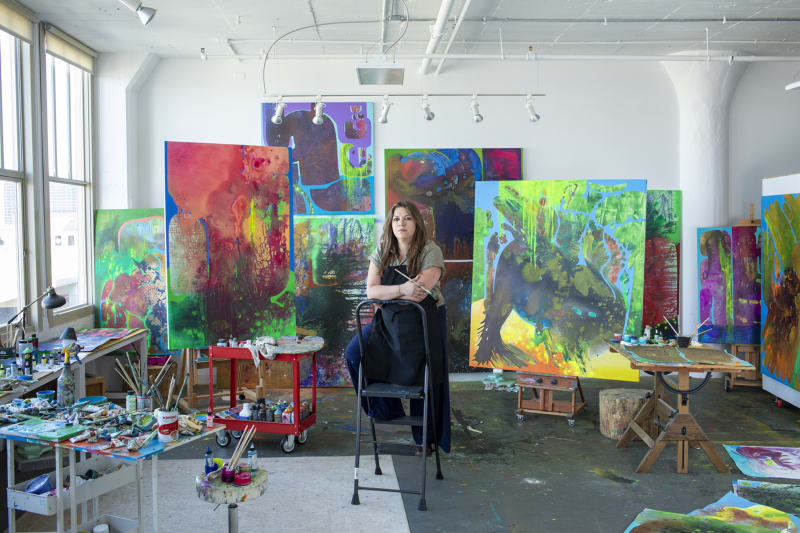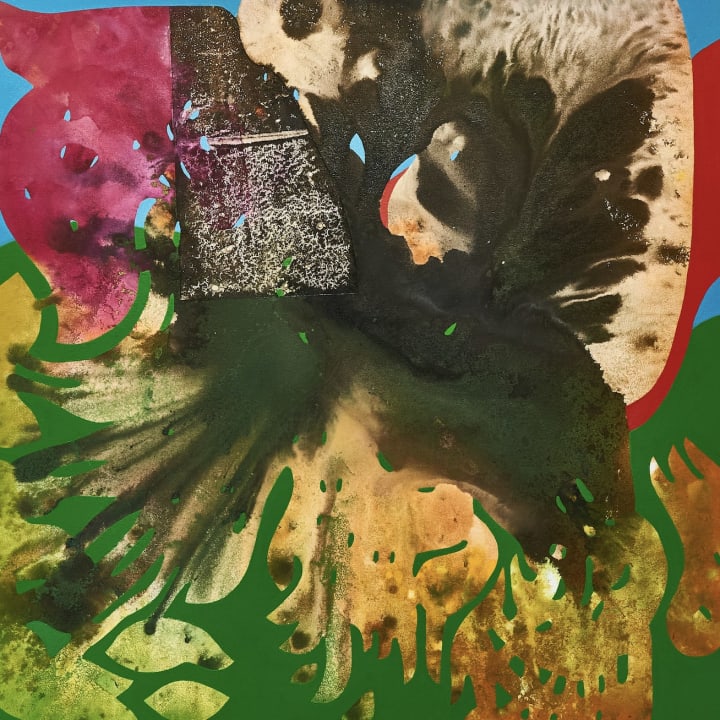HOUSTON, January 15, 2025 — Asia Society Texas (AST) is proud to announce Vian Sora: Outerworlds, a multi-venue mid-career survey of internationally renowned abstract painter Vian Sora (b. 1976, Baghdad). Organized jointly with the Santa Barbara Museum of Art and the Speed Art Museum in Louisville, this exhibition will assemble approximately 20 of Sora’s major works, charting her growth as an artist over a period of seven years (2016–2023). Outerworlds is Sora’s first solo museum exhibition in the United States and will tell the story of how her multivalent paintings abstractly channel the tumultuous events of her life, ancient Mesopotamian history, and Iraq’s diverse natural landscapes, including its deserts, rivers, and archeological sites. Vian Sora: Outerworlds will debut at the Santa Barbara Museum of Art on June 22, 2025 before traveling to the Speed Art Museum, and opening at Asia Society Texas in April 2026.
Born in Baghdad, Sora had her first solo exhibition in Iraq in 2001. She lived through the Iran-Iraq War, the Gulf War, the invasion of Iraq in 2003, and the subsequent insurgency. She later left Iraq, sought refugee status for her family in the United Arab Emirates, and then eventually resettled in Louisville, Kentucky. In 2016, Sora realized she needed to use abstraction to process all that she had lived through from Iraq to the settlement in the United States. Her painting has transformed into a high-powered, bodily, and dynamic practice of controlled chaos. Her canvases reflect an array of radiant paints that are splashed, poured, and sprayed onto the canvas. Pigments run, accumulate, and clash, resulting in upwards of fifty layers of oil and acrylic paint in a single work. For Sora, the multilayered effects of her paintings give a concrete form to the chaos of life. The paintings reference both the realm of biology with its cycles of growth, decay, and evolution, as well as the tumultuous history of her homeland, and inevitable recurrence of wars, violence, and eventual regeneration.
Describing her powerful process, Sora says in a recent Observer interview, “I initiate each of my works with the canvas flat, then I utilize fast-drying spray paint, acrylics, pigments and inks, applying each…with brushes, sponges, spray bottles or my breath to move the medium, creating passages… like ventricles, sometimes tissue. I then use oil to control the disarray, layering various hues in an intuitive process… that attempts to constrain chaos, when life regenerates from detritus.” According to Owen Duffy, the Nancy C. Allen Curator and Director of Exhibitions at Asia Society Texas, “Sora’s paintings brim with dense visuals that can be understood as spaces of visual conflict where hues and colors collide, absorb into one another, and bleed.”
The title, Outerworlds, comes from two eponymous works included in the exhibition that Sora finished in 2021 while in Berlin on a residency. Vian completed this residency during a period of intermittent pandemic lockdowns, when she started to return to social spaces. As Santa Barbara Museum of Art Chief Curator James Glisson shares, “The title is also a reminder that for all of her paintings’ interiority and feeling of completeness — as if there was an entire world laid down on the canvas — these paintings reference cycles of nature and human history. There is growth, decay, violence, healing, frenzy, and quiescence.” Indeed, Morphing (2023) and Floodgates (2021) both convey a generalized sense of transformation and change, while others, such as Antibodies (2020), reference the flagellum of viruses or cells. Sora has said, “This search for beauty amongst destruction is translated into my compositions through a conscious embrace of decay. For me these emotionally intense and bright ‘landscapes’ act as metaphors that simultaneously signify both the turmoil of war and the dynamics of change.” Indeed, the paintings’ upwellings, flows, pools, and eddies are microcosms of the world's endless transformations. “The forms we see in her paintings are elusive and contradictory — they are somehow familiar and alien, surreally swirling with vigor and unexpected gestures,” says Tyler Blackwell, Curator of Contemporary Art at Speed Art Museum. Sora’s paintings, long after they dry, remain in constant visual flux.
These poetic paintings do not only reference their own process of making, or the chaos of war, but they are imbued with references to mythology, history, and the rich geography of Mesopotamia’s ancient Sumer, among the earliest of urban civilizations. These important resonances can be witnessed through Sora’s use of such poignant titles as Abzu, which is Sumerian for fresh water from underground aquifers that helped fertilize the region; Hanging Gardens, as in the Hanging Gardens of Babylon; and Dilmun, an ancient civilization located along the shores of the Persian Gulf, but also a netherworld where the dead lived and Enki, a Sumerian god of water, dwelled. Consequently, Sora’s paintings contain traces of the civilizations and cultures that are part of Iraq’s millennia of recorded history as much as they are in the archeological sites across the country.
“I hope this exhibition will illuminate the struggle, courage and dissonance continuously faced by war survivors that exist between worlds,” says Sora. “As displaced people and immigrants constantly strive to make sense of our new orbits, these paintings depict a journey through distant time and space in order to reach safety.” Reflecting on this exhibition, Sora remarks: “It is the milestone of my career for the prestigious institutions of the Santa Barbara Museum of Art, Speed Art Museum, and the Asia Society Texas to present my first survey museum show, Outerworlds. As a Kurdish Iraqi immigrant, I cherish the opportunity that these museums open their doors for our culture and stories to be shared.”
Vian Sora: Outerworlds is organized by Asia Society Texas, Speed Art Museum, and Santa Barbara Museum of Art. The exhibition is curated by Owen Duffy, Nancy C. Allen Curator and Director of Exhibitions at Asia Society Texas; Tyler Blackwell, Curator of Contemporary Art, Speed Museum of Art; and James Glisson, Chief Curator, Santa Barbara Museum of Art.


